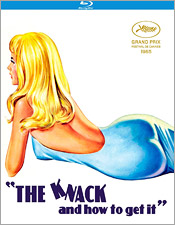Knack… and How to Get It, The (Blu-ray Review)

Director
Richard LesterRelease Date(s)
1965 (January 12, 2016)Studio(s)
United Artists (Kino Lorber Studio Classics)- Film/Program Grade: B
- Video Grade: B
- Audio Grade: B+
- Extras Grade: B-
Review
Richard Lester is possibly the most influential director who has been more or less forgotten – at least in proportion to his one-time importance and popularity – outside of a devoted coterie of filmmakers and buffs. Part of the problem, ironically, may be his diversity; although a certain idiosyncratic sense of humor characterizes most of his movies, he jumped across genres and budgets so frequently that his career is tough to get a handle on. After all, what can you say about the guy who made both the first great rock and roll movie (A Hard Day’s Night) as a scrappy English-language answer to the French New Wave and brought Richard Pryor to the Superman series? (Admittedly, Superman III may not be one of Lester’s high points. But Superman II sure is!) His best films include a poignant, meditative Robin Hood picture with Sean Connery and Audrey Hepburn (Robin and Marian), a rousing ensemble action film that set the template for Speed and its ilk (Juggernaut), absurdist and oddly prescient comedies (How I Won the War, The Bed Sitting Room), classical adventure films with a modernist spin (The Three Musketeers, The Four Musketeers), and one-of-a-kind masterpieces like Petulia and Cuba.
The list goes on, but Lester’s reputation has waned in spite of the best efforts of directors like Steven Soderbergh (who wrote an indispensable book on Lester) and John Landis to keep the flame burning. Yet in the 1960s, Lester was a god to many young cinephiles (including future Rock and Roll High School director Allan Arkush) as he cranked out one funky, audacious gem after another. He even won the Palm d’Or at the 1965 Cannes Film Festival for his experimental comedy The Knack…and How to Get It, which has now been issued on Blu-ray by the good folks at Kino Lorber. The Knack hasn’t aged quite as well as many of Lester’s later, more emotionally resonant pictures (it seems awfully flimsy next to the masterful Robin and Marian and Cuba), but its youthful exuberance and gorgeous black and white cinematography go a long way toward compensating for its dated aspects – and it’s a great primer on what made Lester so important.
The story itself is mostly a pretext for cinematic playfulness: three young men who share a flat in swinging London comically clash over their differing attitudes toward women (and their apartment). One guy is a womanizer, one a hopeless dork desperately looking for romance, and the other only cares about redecorating the flat but claims he’s not gay. Their lives are somewhat upended by the arrival of a naïve young girl who both the womanizer and the dork are interested in – can the nerd get “the knack” for talking to women and woo her away from his roommate? If the premise sounds like something out of a sitcom, the execution is anything but; Lester employs a variety of new wave editing techniques and highly unrealistic and expressive sound design to generate both laughs and an impressionistic sense of what is going on in the guys’ heads. Time speeds up and slows down, jump cuts abound, and passersby comment on the action even when they are not a part of it. It makes for a viewing experience that’s simultaneously smart and silly, and visually sumptuous thanks to the photography by the legendary David Watkin (Out of Africa, Moonstruck, and a lot of other Lester pictures). Shooting in black and white, Watkin creates imagery that combines the naturalism of the period with more beautiful, lyrical lighting effects – his juxtapositions shouldn’t necessarily work together, but they do, perfectly.
Less effective are some of the movie’s extremely dated sex jokes, including a running gag revolving around Rita Tushingham thinking she’s been raped when she hasn’t. It’s a bit unpleasant, and the fact that Lester hammers it into the ground for a solid fifteen minutes or so doesn’t help matters; the one thing that saves it is the sheer naiveté of the characters (and by extension, perhaps, the filmmakers). The Knack is a movie of its time, both for better and worse, but mostly better, especially when it comes to Lester and Watkin’s filmmaking innovations. There’s a lot of great stuff here for young directors to steal (one of the advantages for other filmmakers of Lester’s diminished viewership), and the movie serves as a great introduction to Lester’s techniques before one moves on to the deeper pleasures of his later work. The Blu-ray transfer is solid but somewhat marred by uneven source material, particularly toward the beginning of the film when the print is plagued by scratches and debris. Extras are minimal but fun: a pair of commentaries by Arkush and Landis on Lester trailers from Joe Dante’s wonderful “Trailers From Hell” website.
- Jim Hemphill

